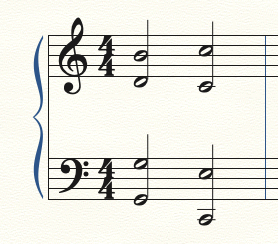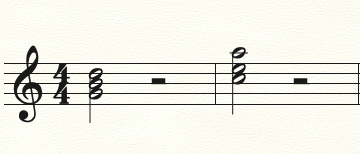3.1 Triad and Chord Qualities (M, m, d, A)
7 min read•january 13, 2023
AP Music Theory 🎶
72 resourcesSee Units
When we listen to music, it is the chords that make up a harmony. Chords are defined by having at least 3 pitches and are played (or sung) at the same time. Chords can also be implied if pitches are played in a group, such as an arpeggio.
Here is an example of a chord played simultaneously:

Here is an example of an arpeggio, which outlines the tones of a chord.

Chords and harmonies are important because they add depth to the music, and they give the music a sense of motion, tension, and resolution. In the tradition of Western music, there are two basic types of chords:
In the tradition of Western music, there are two basic types of chords:
- Triads: chords that consist of 3 distinct pitches, a combination of two thirds (intervals) stacked on one another

- Seventh chords: chords that consist of 4 distinct pitches, a combination of three thirds (intervals) stacked on one another.

Triads
In music theory, a triad is considered a basic building block of tonal harmony, and it is the most common type of chord found in Western classical music and other styles of music. The word "triad" comes from the Latin word "tres," meaning "three," and triads are usually built by stacking thirds on top of each other.
There are four types of triads: major (M), minor (m), diminished (d), and augmented (A). A major triad consists of a root note, a major third interval above the root, and a perfect fifth interval above the root. A minor triad consists of a root note, a minor third interval above the root, and a perfect fifth interval above the root. A diminished triad consists of a root note, a minor third interval above the root, and a diminished fifth interval above the root. An augmented triad consists of a root note, a major third interval above the root, and an augmented fifth interval above the root.
Triads are typically played with the root note in the bass, or lowest part, and the other two notes stacked on top. However, they can also be played in inversions, where the root note is not in the bass. In a first inversion triad, the middle note is played in the bass, and in a second inversion triad, the top note is played in the bass. Inverting a triad can change the overall sound and feel of the chord, and we will usually invert chords so we can have good voice leading in our music.

From right to left: C Major, C minor, C diminished, C augmented
All the above chords, no matter their quality, consider this to be in the root position when the tonic of a chord is at the bottom of the triad. The tonic here is C.
Looking Ahead: Seventh Chords
Seventh chords are chords that consist of four notes, with the fourth note being a seventh interval above the root note. Like triads, seventh chords are an important part of tonal harmony and are found in many different styles of music. There are several types of seventh chords, including major seventh chords, minor seventh chords, dominant seventh chords, diminished seventh chords, and half-diminished seventh chords.
A major seventh chord consists of a root note, a major third interval above the root, a perfect fifth interval above the root, and a major seventh interval above the root. It has a bright, happy sound and is often used to create a sense of resolution or closure in a piece of music. We might also write major seventh chords as MM chords, since there is a major triad followed by a major third.
A minor seventh chord (mm) consists of a root note, a minor third interval above the root, a perfect fifth interval above the root, and a minor seventh interval above the root. It has a more mellow, contemplative sound and is often used to create a sense of tension or dissonance.
A dominant seventh chord (Mm) consists of a root note, a major third interval above the root, a perfect fifth interval above the root, and a minor seventh interval above the root. It is one of the most common types of seventh chords and is used extensively in blues, jazz, and rock music. It has a strong, bluesy sound and is often used to create a sense of tension or instability that needs to be resolved.
A diminished seventh chord consists of a root note, a minor third interval above the root, a diminished fifth interval above the root, and a diminished seventh interval above the root. It has a very tense, dissonant sound and is used to create a sense of instability or unease.
The half-diminished seventh chord is similar to a diminished seventh chord, but with a minor seventh interval instead of a diminished seventh interval. Sometimes, we will denote seventh chords with a little circle and a line through it. It has a very tense, dissonant sound and is often used to create a sense of instability or unease in a piece of music.
The half-diminished seventh chord is often used as a substitute for a dominant seventh chord in jazz, and it is an important part of the harmonic language of the genre. It can also be found in classical music, where it is sometimes used to create a sense of tension or dissonance that needs to be resolved. In rock and pop music, the half-diminished seventh chord is not as common, but it can be used to add variety and interest to chord progressions and melodies.
Seventh chords are typically played with the root note in the bass, or lowest part, and the other three notes stacked on top. Like triads, they can also be played in inversions, where the root note is not in the bass. In a first inversion seventh chord, the middle note (the third) is played in the bass, and in a second inversion seventh chord, the fifth is played in the bass. There is also a third inversion, where the seventh is played in the base, but this inversion is not used very frequently.
Here are examples of the different types of seventh chords

Image via Music Theory Teacher
🦜Polly wants a progress tracker: How do you spell a Bb major chord? How do you spell a 7th chord in E minor?
Identifying Triads and Seventh Chords by Ear
On the AP Music Theory Exam, you will have to identify the type, quality, and inversion of a chord by ear, given a specific chord progression. There are several strategies that you can use to help you identify triads and seventh chords by ear.
One strategy is to listen for the intervals between the notes in the chord. Triads and seventh chords will both consist of four notes, but in triads, one note will be doubled. Listening for intervals is a little dangerous because the chords might be inverted, but if you are sure about one note and you can get a second note using this method, you will be able to identify the chord much more easily.
Another strategy is to listen for the overall sound and feel of the chord. Different types of triads and seventh chords have distinctive sounds that can help you identify them. For example, major triads have a bright, happy sound, minor triads have a more mellow, contemplative sound, and diminished triads have a tense, dissonant sound.
Similarly, dominant seventh chords have a strong, bluesy sound, minor seventh chords have a more mellow, relaxed sound, and half-diminished seventh chords have a very tense, dissonant sound. By listening for these characteristics, you can get a sense of the type of triad or seventh chord that you are hearing.
You can also use your knowledge of chord progressions and common harmonic patterns to help you identify triads and seventh chords by ear. Many songs follow predictable chord progressions, and if you know what to listen for, you can often predict what chord will come next based on the chords that have come before.
For example, you might expect to hear a V-I cadence at the end of the chord progression. If you look at past AP exams, there are many such patterns that they like to reuse. By listening for these patterns, you can get a better sense of the overall structure of the music and make more accurate identifications of the chords that you are hearing.
Finally, you can use your knowledge of scales to help you identify triads and seventh chords by ear. Different scales and modes have distinctive patterns of whole and half steps that can help you identify the root notes of chords and the intervals between them.
For example, if you know that a piece of music is in the key of C major, and you hear a chord with a root note of G, a major third interval above the root, and a perfect fifth interval above the root, you can infer that the chord is a G major triad, since these intervals match the intervals in the G major scale. Often, listening for the root note will help you identify the chord, because there are only a few possibilities given other context clues.
I used the website Teoria to practice identifying chord progressions. You can start with only a few chords, and add more complex ones as you move on.
Browse Study Guides By Unit
🎵Unit 1 – Music Fundamentals I (Pitch, Major Scales and Key Signatures, Rhythm, Meter, and Expressive Elements)
🎶Unit 2 – Music Fundamentals II (Minor Scales and Key Signatures, Melody, Timbre, and Texture)
🎻Unit 3 – Music Fundamentals III (Triads and Seventh Chords)
🎹Unit 4 – Harmony and Voice Leading I (Chord Function, Cadence, and Phrase)
🎸Unit 5: Harmony and Voice Leading II: Chord Progressions and Predominant Function
🎤Unit 7 – Harmony and Voice Leading IV (Secondary Function)
📝Exam Skills
📆Big Reviews: Finals & Exam Prep

Fiveable
Resources
© 2023 Fiveable Inc. All rights reserved.